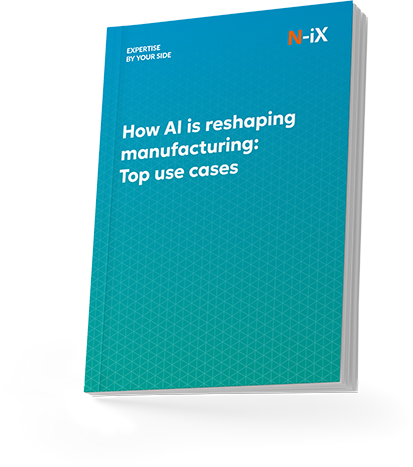Cybersecurity for manufacturing becomes a core priority as the industry faces an unprecedented wave of cyberattacks. Nearly two-thirds (65%) of manufacturing companies reported ransomware attacks in 2024. Unless businesses reinforce their security, even more can suffer production disruptions, enormous financial losses, and safety hazards.

As the manufacturing sector grows more reliant on connectivity, preparing to divert new attack vectors is paramount. In this guide, our experts identify the most pressing cyber threats to the manufacturing industry and outline practical approaches to enhance your security without disrupting operations.
Key cybersecurity manufacturing threats businesses face
Cyber attacks targeting manufacturing systems are becoming not only more frequent but also more sophisticated. So, what are the greatest risks to manufacturing cybersecurity? Our experts highlight key attack techniques causing significant damage across the industry.
Ransomware attacks that suspend production
The manufacturing sector is sensitive to downtime, and cybercriminals actively exploit this vulnerability. They target manufacturing companies with ransomware, aiming to stall operations and inflict financial losses. Since most businesses in this industry depend on continuous production, they are more likely to pay the demanded ransom. As a result, those without strong preventive measures often face prolonged production delays and costly recovery efforts.
Intellectual property (IP) theft targeting proprietary innovations
Data breaches represent one of the most financially damaging threats, with losses averaging $4.88M per breach. Intellectual property records, in particular, are targeted in 43% of such attacks. Malicious actors specifically target manufacturing firms, exploiting security gaps to steal valuable trade secrets and proprietary designs. These stolen innovations are systematically reverse-engineered to create competing products, severely undermining enterprises’ competitive advantages in the global marketplace.
Supply chain breaches from third-party vendors
Supply chain vulnerabilities are growing increasingly critical as manufacturers expand their digital connectivity with suppliers and vendors. Third-party software, firmware, and hardware components introduce risks that, when exploited, typically create direct pathways into core manufacturing systems. These compromises often go undetected for extended periods, allowing attackers to maintain persistent access.
ICS and OT system compromise leading to operational sabotage
Equipment sabotage through compromised industrial control systems (ICS) and operational technology (OT) is an escalating threat due to the prevalence of legacy software in industrial environments. Unlike traditional data breaches, these attacks can disable critical safety systems and cause serious physical damage to people and machinery. They put both worker safety and operational continuity at risk.
Insider threats compromising data and operations
Manufacturing ranks among the top industries most vulnerable to insider security incidents. A significant portion of such breaches stems from negligent employees making critical mistakes in system operations and security protocols. These internal threats remain consistently under-addressed despite their frequency and impact.

Transform manufacturing operations with AI—get the expert guide now!


Success!

Cybersecurity for manufacturing best practices in 2025
Protecting manufacturing operations requires systematic approaches that address both technological and human factors. While no organization can prepare for every possible threat, focusing on the right priorities helps build security that’s flexible and ready to deflect unexpected attacks. Let’s explore seven best practices to achieve greater resilience.
1. Organize around strategic priorities, not just tactics
In many cases, cybersecurity in manufacturing is treated as a checklist of tools and quick fixes. But to build real and lasting resilience, manufacturing leaders must think strategically. Cybersecurity must be tied to core business priorities rather than focus solely on addressing separate issues as they emerge. That means understanding not just what your risks are but which systems have the largest impact on your business operations.
Our security experts recommend starting by identifying those critical processes, data, and infrastructures, also collectively known as your minimum viable company. This clarity helps prioritize investments and focus protection where it matters most. At N-iX, we guide manufacturers through this process, helping them make informed, strategic security decisions that support long-term business continuity and growth.
2. Secure the converged IT/OT environment
As digital and operational technologies converge, the traditional boundaries separating IT and OT environments continue to dissolve. This integration delivers operational advantages but also introduces new security vulnerabilities. Without comprehensive visibility across these interconnected systems, even minor security breaches can cascade throughout the network. Securing this convergence requires a unified approach that accounts for real-time interactions between digital and physical infrastructures.
When N-iX engineers design strong cybersecurity for manufacturing, they ensure protection across IT/OT environments by implementing the following practices:
- Network segmentation: We divide networks into distinct security zones to contain breaches and prevent attackers from moving laterally, effectively limiting the potential damage radius.
- Air-gapping critical systems: We physically isolate essential OT infrastructure from Internet-connected environments where possible, creating an additional security barrier against remote threats.
- Strict access control policies: Through robust identity and access management, we mitigate insider risks and restrict privilege escalation capabilities within converged environments.
- Conducting regular OT-specific risk assessments: We perform targeted evaluations of legacy hardware, protocol vulnerabilities, and operational constraints, helping manufacturers prioritize security improvements based on business impact.

3. Strengthen endpoint and device protection
In manufacturing environments, endpoints include industrial control systems, legacy operational technology, sensors, and a growing array of IoT components. Many of these devices were never designed with security in mind, making them attractive targets for cybercriminals. Without proper protection, a single compromised endpoint can provide attackers with a gateway to infiltrate broader operations.
To reduce this risk, N-iX engineers recommend combining proactive monitoring with adaptive protection measures. Establish systematic patching programs for both modern and legacy devices to address known vulnerabilities while preserving operational continuity. Also, deploy behavior-based threat detection solutions that identify suspicious activity and OT anomalies in real time. It will help catch threats that traditional signature-based tools often miss.
4. Enhance supply chain and vendor risk management
In today’s interconnected manufacturing ecosystems, third-party vendors often have deep access to critical systems and data. That makes your supply chain not just a logistical concern but a cybersecurity one. A single compromised partner can expose vulnerabilities across your entire operation. As cybersecurity in the manufacturing industry becomes increasingly complex, robust third-party risk assessments are essential for protecting both data and production continuity.
A comprehensive vendor risk assessment should evaluate:
- Security protocols and encryption methods: How vendors protect data in transit and at rest, especially when integrated with internal systems;
- Risk management practices: Vendors’ ability to identify, assess, and respond to threats within their own environments;
- Compliance with cybersecurity standards: Adherence to industry regulations such as NIST, ISO 27001, or sector-specific frameworks;
- Data exchange protocols: How data is shared, accessed, and monitored between organizations to prevent leaks or misuse.

Additionally, our experts note that many organizations lack documented incident management policies for responding to third-party breaches. Without clear procedures, response efforts can be significantly delayed. Make sure to establish and regularly test such policies to enable a faster, more coordinated reaction if a vendor incident occurs.
5. Plan for quick recovery
Cyberattacks can’t always be prevented, but the ability to recover quickly is what defines strong cybersecurity for manufacturing. Building resilience starts with having the right tools, plans, and metrics in place before a crisis hits. Our security experts highlight the following steps to minimize disruption:
- Develop incident response playbooks: Outline clear disaster recovery steps and timelines for restoring critical assets.
- Develop clear resilience metrics: Track detection time, response speed, and ability to reduce business impact.
- Perform regular data backups: Protect both business data and essential operational configurations to support full system recovery.
- Secure cyber insurance tailored to manufacturing: Cover industry-specific risks, such as prolonged downtime and equipment damage, with policies that reflect your exposure.
6. Align with compliance frameworks
Manufacturing organizations often face multiple regulatory requirements, including the NIST Cybersecurity Framework in the US and the NIS2 Directive in the European Union. There are also specific standards that address industrial automation security, such as IEC 62443.
Maintaining compliance is mandatory to avoid penalties, but it’s also key to building strong, repeatable security practices. In the context of cybersecurity and manufacturing, regulations help enforce consistent controls across systems, facilities, and regions. By aligning with recognized standards, manufacturers strengthen both their defenses and their ability to respond effectively in the event of incidents.
7. Create a culture of security across all roles
Most cyber incidents result from human error. Successful manufacturers cultivate ongoing security awareness through regular training and clear communication of policies. Security responsibilities must extend beyond IT teams to include operational staff, creating shared accountability across departments.
How N-iX can help you improve cybersecurity for manufacturing
The manufacturing sector’s future depends not just on technological innovation but on the effectiveness of the security measures protecting those innovations.
With 23 years of experience and over 100 successful security projects across various industries, N-iX is a reliable cybersecurity partner prepared to address the unique challenges of manufacturing environments.
- Our experts perform infrastructure vulnerability assessments, code reviews, and penetration testing to identify weaknesses before attackers can exploit them.
- We can handle 24/7 threat monitoring, incident detection, and rapid response while your teams focus on core business operations.
- Our assessments extend beyond standard IT evaluations to include specialized OT system analysis, enabling you to understand your true security posture across interconnected production environments.
- Our team can assess your current security practices against relevant frameworks such as ISO 27001, NIST, and IEC 62443, helping you develop clear roadmaps for achieving and maintaining compliance. We can also prepare control remediation plans and provide support during certification audits.
- We secure converged IT and OT systems through proper network segmentation, protected communication channels, and unified governance models that correspond to the unique requirements of both environments.
- Being ISO 27001, ISO/IEC 27701:2019, SOC 2, and PCI DSS certified, N-iX is prepared to deliver reliable services from assessment through implementation and ongoing support.
Have a question?
Speak to an expert




